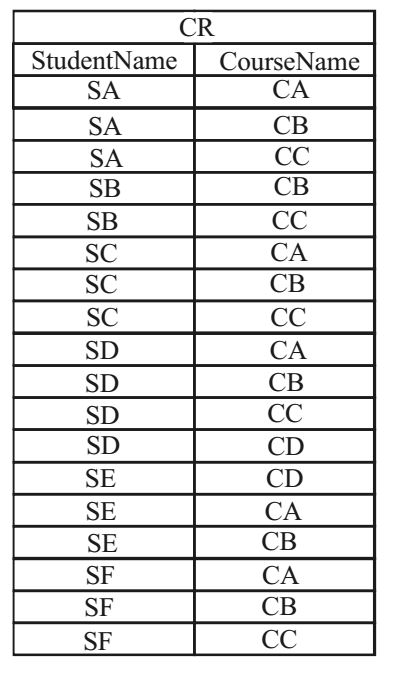Database miscellaneous
- Consider the following relations :

Consider the following SQL query. SELECT S.
Student_Name, sum (P.Marks)
FROM Student S, Performance P
WHERE S.Roll_No. = P.Roll_No.
GROUP BY S.Student_Name
The number of rows that will be returned by the SQL query is _______.
-
View Hint View Answer Discuss in Forum
Output table is

Correct Option: B
Output table is

- Consider a database that has the relation schema CR(StudentName. CourseName). An instance of the schema CR is as given below.

The following query is made on the database.
T1 ← πCourseName (σStudentName= ‘SA’(CR))
T2 ← CR ÷ T1
The number of rows in T2 is _______.
-
View Hint View Answer Discuss in Forum
The given query is made on the database are:
1.
For T1 Result: find out the course name for the student name is ‘SA’ i.e.
So, T1 = {CA, CB, CC} The number of rows in T1 is 3.
2. T1 ← (CR ÷ T1)
For T2 Result: find out the student name for which every course name of T1 are {CA, CB, CC} is:
So, T2 = {SA, SC, SD, SF} Hence, the number of rows in T2 is 4.Correct Option: C
The given query is made on the database are:
1.
For T1 Result: find out the course name for the student name is ‘SA’ i.e.
So, T1 = {CA, CB, CC} The number of rows in T1 is 3.
2. T1 ← (CR ÷ T1)
For T2 Result: find out the student name for which every course name of T1 are {CA, CB, CC} is:
So, T2 = {SA, SC, SD, SF} Hence, the number of rows in T2 is 4.
- Consider the following database table named water_schemes:

The number of tuples returned by the following SQL query is ________.
with total (name, capacity) as
select district_name, sum (capacity)
from water_schemes
group by district_name
with total_avg (capacity) as
select avg (capacity)
from total
select name
from total, total_avg
where total.capacity ≠ total_avg.capacity
-
View Hint View Answer Discuss in Forum
First we should perform group by group. We get ajmer 1
bikaner 3
charu 2
dungargarh 1
Now we should perform total capacity we will get 100. Now perform avg. capacity on total 100 / 4 = 25. bikaner = 40 which is greater than 25 charu is 30 which is also greater than 25. Hence charu and bikaner will be printed therefore answer is 2 tuples.Correct Option: A
First we should perform group by group. We get ajmer 1
bikaner 3
charu 2
dungargarh 1
Now we should perform total capacity we will get 100. Now perform avg. capacity on total 100 / 4 = 25. bikaner = 40 which is greater than 25 charu is 30 which is also greater than 25. Hence charu and bikaner will be printed therefore answer is 2 tuples.
- SELECT operation in SQL is equivalent to
-
View Hint View Answer Discuss in Forum
SELECT operation in SQL perform vertical partitioning which is made by projection operation in relational calculus, but SQL is multi-sets. Hence the projection operation in relational algebra, except that SELECT in SQL retains duplicates answer is correct.
Correct Option: D
SELECT operation in SQL perform vertical partitioning which is made by projection operation in relational calculus, but SQL is multi-sets. Hence the projection operation in relational algebra, except that SELECT in SQL retains duplicates answer is correct.
- Consider a database that has the relation schema EMP (EmpId. EmpName, and DeptName). An instance of the schema EMP and a SQL query on it are given below.

The output of executing the SQL query is_______.
-
View Hint View Answer Discuss in Forum

Result of outer query or Avg (NUM) = 13 = 2.6 5 Correct Option: B

Result of outer query or Avg (NUM) = 13 = 2.6 5

